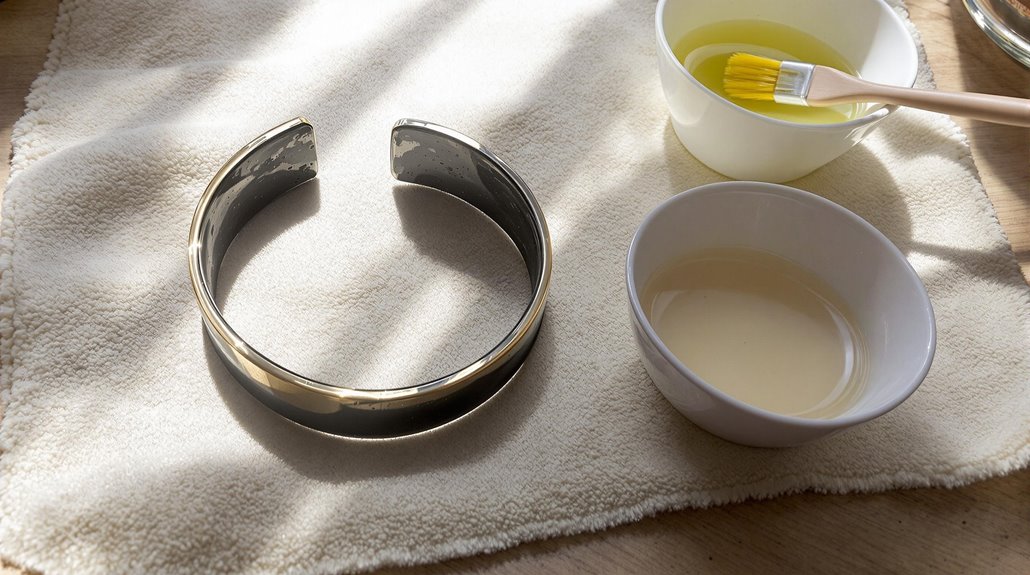Picture your favorite bronze jewelry piece, its warm metallic glow dulled by time and wear. I’ve spent years learning the secrets of keeping bronze beautifully lustrous, and I’m ready to share my tried-and-true cleaning methods with you. While many people accidentally damage their pieces with harsh chemicals or incorrect techniques, I’ll show you how to safely restore and maintain your bronze jewelry’s natural shine, preserving both its value and its stories for years to come.
Understanding Bronze Jewelry Properties

Bronze jewelry, a beloved alloy of copper and tin, brings a distinctive warmth and character to any collection, but it requires specific care to maintain its beauty.
I’ve found that understanding the bronze composition is essential – typically containing about 90% copper and 10% tin, which gives your pieces their signature reddish-brown hue and remarkable jewelry durability.
When I examine bronze pieces, I notice they’re naturally resistant to corrosion but can develop a greenish patina over time, which some collectors actually prize.
I always tell my readers that while bronze is sturdy enough for daily wear, it’s softer than gold or platinum, so you’ll want to store it carefully to prevent scratches.
You should also know that bronze can temporarily leave green marks on your skin, especially in humid conditions.
Essential Tools and Materials for Cleaning
Keeping your treasured jewelry pieces clean starts with gathering the right tools, and I’ve learned exactly what works best through years of experience.
First, you’ll need gentle cleaning solutions like mild dish soap or specialized jewelry cleaner, plus a soft-bristled toothbrush and clean water. I always recommend having microfiber polishing cloths on hand, as they’re perfect for buffing without scratching.
In my toolkit, I also keep cotton swabs for reaching tight spots, a small bowl for soaking, and lint-free paper towels for drying.
If you’re dealing with tougher tarnish, you might want to add a commercial bronze cleaner to your supplies, but I’d suggest starting with gentler options first.
Remember to avoid harsh chemicals that could damage your pieces.
Quick Daily Care and Maintenance Tips
Since proper daily maintenance prevents long-term damage, I’ve developed some simple habits that’ll keep your bronze jewelry looking beautiful between deep cleanings.
After wearing your pieces, I recommend gently wiping them with a soft, dry microfiber cloth to remove oils, sweat, and daily grime before storage.
In my daily cleaning routine, I make sure to keep bronze jewelry away from water, perfumes, and lotions that can accelerate tarnishing.
When you’re not wearing your pieces, store them individually in anti-tarnish bags or cloth pouches, as contact with other metals can cause unwanted reactions.
I’ve found that maintaining this simple maintenance routine helps preserve your bronze jewelry’s natural patina while preventing the buildup of harmful compounds.
Natural Cleaning Methods for Bronze

When your bronze jewelry needs a thorough yet gentle cleaning, several natural ingredients from your kitchen can deliver amazing results.
I’ve found that natural acids like lemon juice and white vinegar work wonders when mixed with warm water in equal parts. For a gentle DIY solution, I recommend combining 1 tablespoon of salt with 1 cup of these mild acidic mixtures.
I’ll often use ketchup, which contains natural acids and tomato paste, to clean particularly tarnished pieces – just apply a thin layer, wait 15 minutes, and rinse thoroughly.
For a softer approach, I mix baking soda with lemon juice to create a paste that’s perfect for detailed cleaning.
Remember to rinse your jewelry completely with clean water and dry it immediately with a soft, lint-free cloth.
Dealing With Stubborn Tarnish and Patina
Although stubborn tarnish and patina can be frustrating to remove from bronze jewelry, I’ve discovered several effective techniques that’ll help restore your pieces to their original luster.
For tough tarnish removal techniques, I recommend creating a paste using baking soda and lemon juice, then gently working it into the affected areas with a soft cloth.
If you’re dealing with extensive patina, I’ve found that a solution of equal parts white vinegar and salt works wonders when applied carefully with a cotton swab.
When using these patina restoration methods, always test on a small, hidden area first to verify it won’t damage your piece.
Remember to rinse thoroughly with clean water and dry completely with a microfiber cloth to prevent water spots or additional tarnishing.
Professional Cleaning Options and Services
While many bronze jewelry cleaning tasks can be handled at home, certain pieces may require professional attention to restore their beauty safely and effectively.
I recommend seeking professional services for antique pieces, items with gemstones, or bronze jewelry that holds significant value.
When I take my bronze pieces to a professional, I make sure they’re experienced with various cleaning techniques and understand the unique properties of bronze.
You’ll find qualified jewelers at established jewelry stores, antique restoration specialists, and dedicated metal cleaning services.
I suggest asking about their specific methods, including ultrasonic cleaning, professional polishing, and protective coating applications.
Before committing to any service, I always check reviews, ask for references, and discuss pricing upfront to guarantee I’m getting reliable, expert care for my cherished bronze pieces.
Proper Storage and Protection Techniques

Since proper storage plays an essential role in maintaining bronze jewelry’s beauty and preventing tarnish, I’ve developed several reliable methods to protect my pieces.
I recommend storing your bronze items in airtight storage containers or protective pouches lined with anti-tarnish fabric, keeping them away from direct sunlight and moisture.
When I’m not wearing my bronze jewelry, I place each piece separately to prevent scratches and store them in a cool, dry place like my bedroom dresser drawer.
If you’re traveling, I suggest wrapping individual pieces in soft cloth before placing them in your jewelry case.
I’ve found that adding small silica gel packets to your storage containers helps absorb excess moisture, while maintaining proper humidity levels that prevent both tarnish and corrosion.
Common Mistakes to Avoid When Cleaning
Because improper cleaning techniques can permanently damage bronze jewelry, I’ve learned to avoid several common mistakes that many collectors make.
Never use harsh cleaning solutions like bleach or ammonia, as they’ll corrode your bronze pieces beyond repair. I’ve found that excessive cleaning frequency can wear down the protective patina that gives bronze its character.
Don’t scrub your pieces with abrasive materials like steel wool or rough brushes – even if you’re dealing with stubborn tarnish.
I recommend avoiding hot water when cleaning, as it can weaken the metal’s structure. One mistake I often see is people not drying their jewelry thoroughly after cleaning, which leads to water spots and potential oxidation.
Finally, don’t store your bronze pieces while they’re still damp, as this can trigger unwanted chemical reactions.
Long-term Preservation and Care Guidelines
To guarantee your bronze jewelry remains beautiful for generations, proper long-term care and storage methods are essential. I’ve found that implementing preventive measures, like storing pieces separately in soft cloth bags, makes a huge difference in preserving their condition. Let me share my tested care routines that’ll help protect your treasures.
| Storage Method | Environment | Maintenance |
|---|---|---|
| Cloth bags | Cool, dry place | Monthly check |
| Airtight boxes | Low humidity | Quarterly clean |
| Display cases | Away from sun | Yearly polish |
I recommend checking your bronze pieces monthly for signs of tarnish or corrosion. When you’re not wearing them, store them in a climate-controlled area away from direct sunlight and harsh chemicals. If you’ll be storing pieces long-term, I suggest adding silica gel packets to absorb excess moisture.







